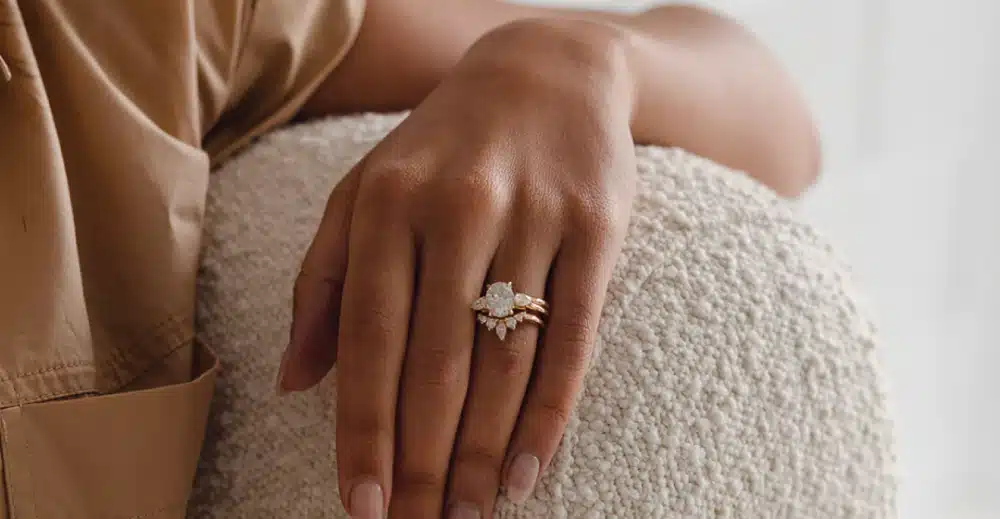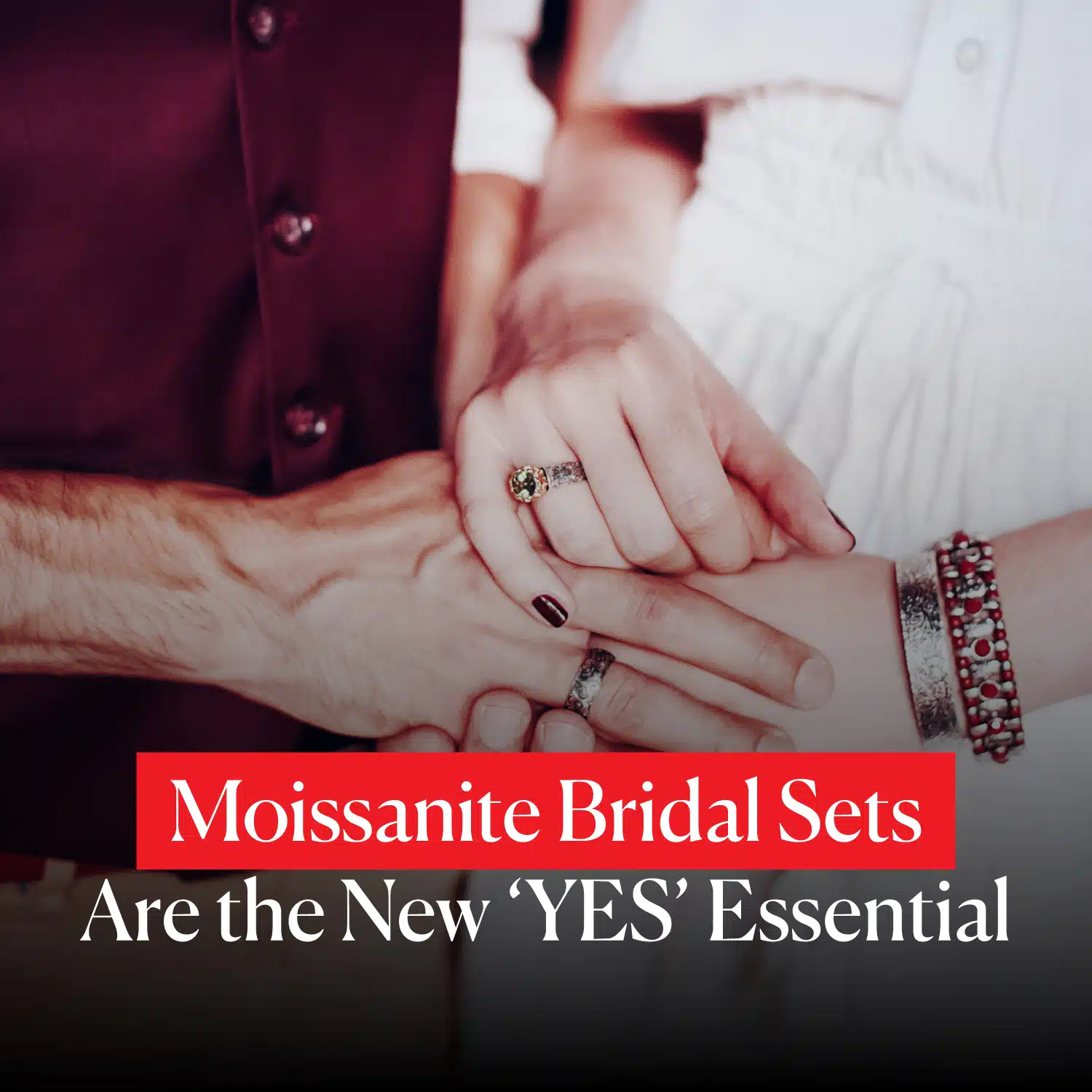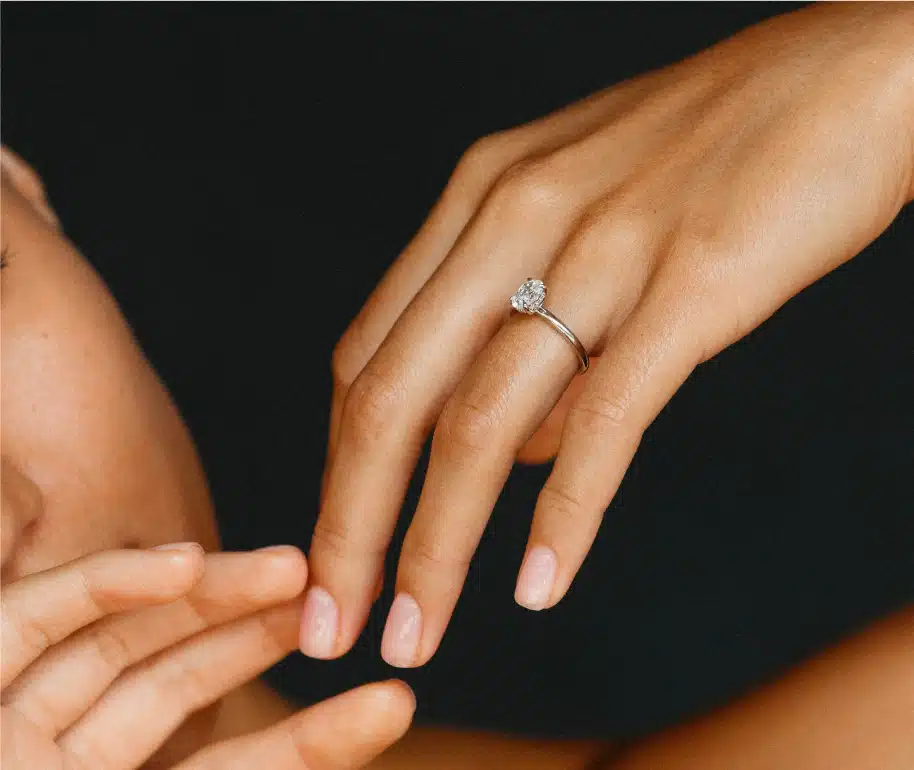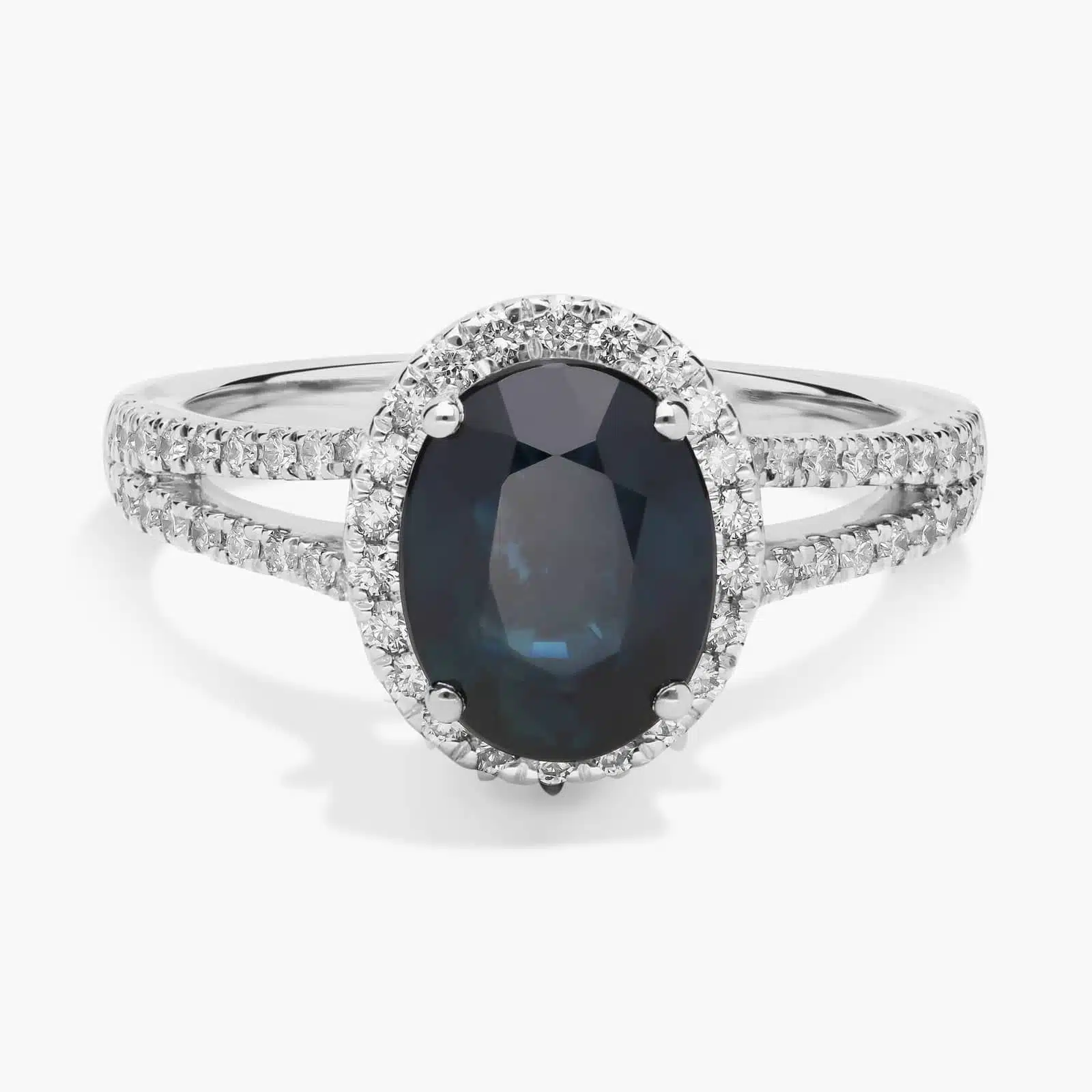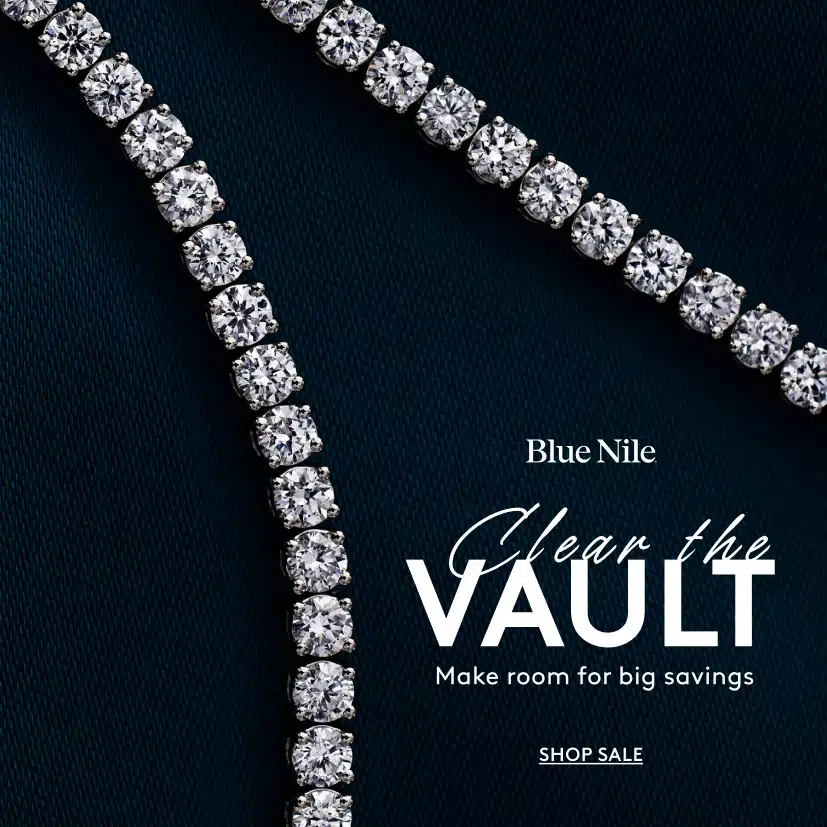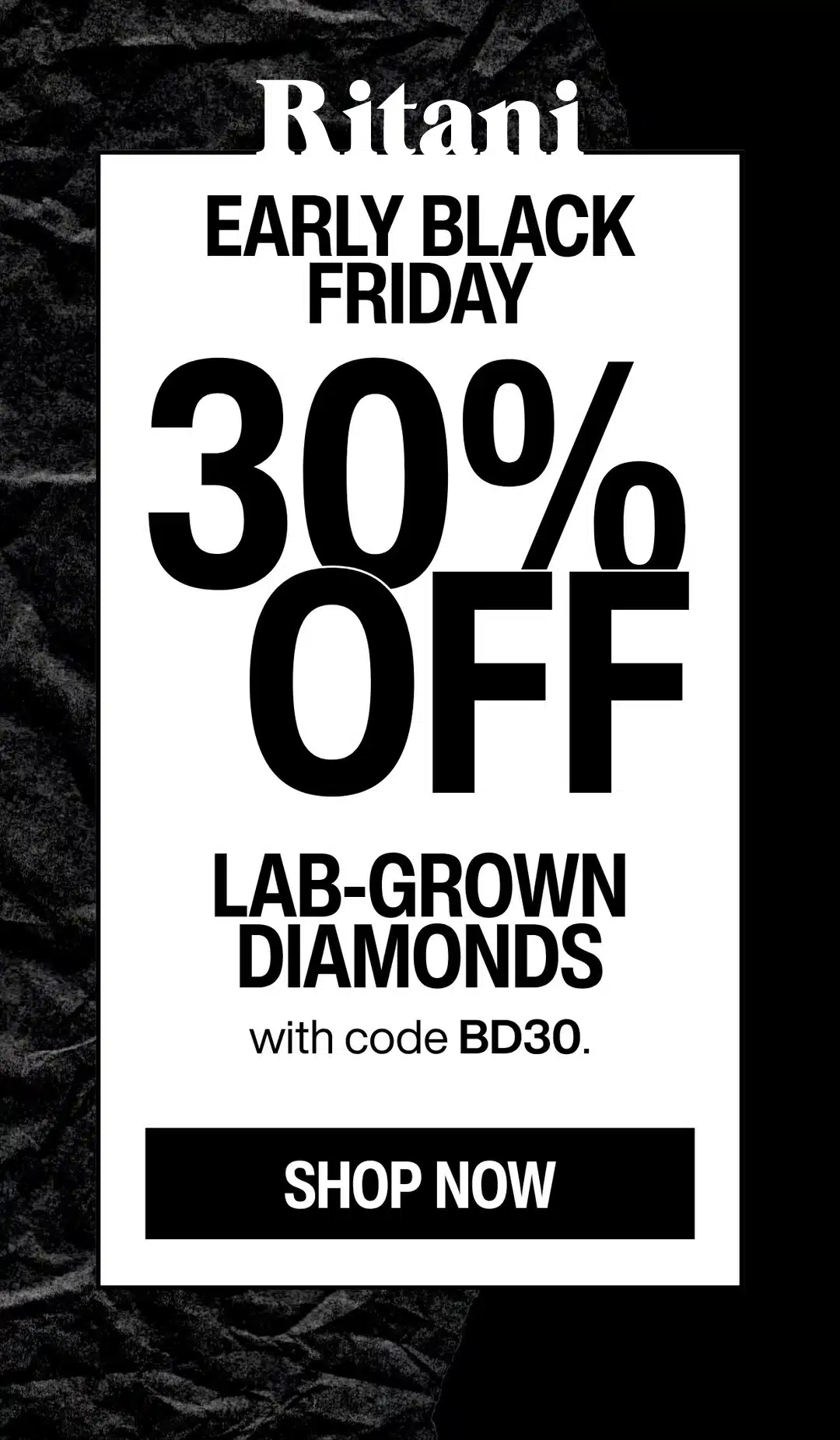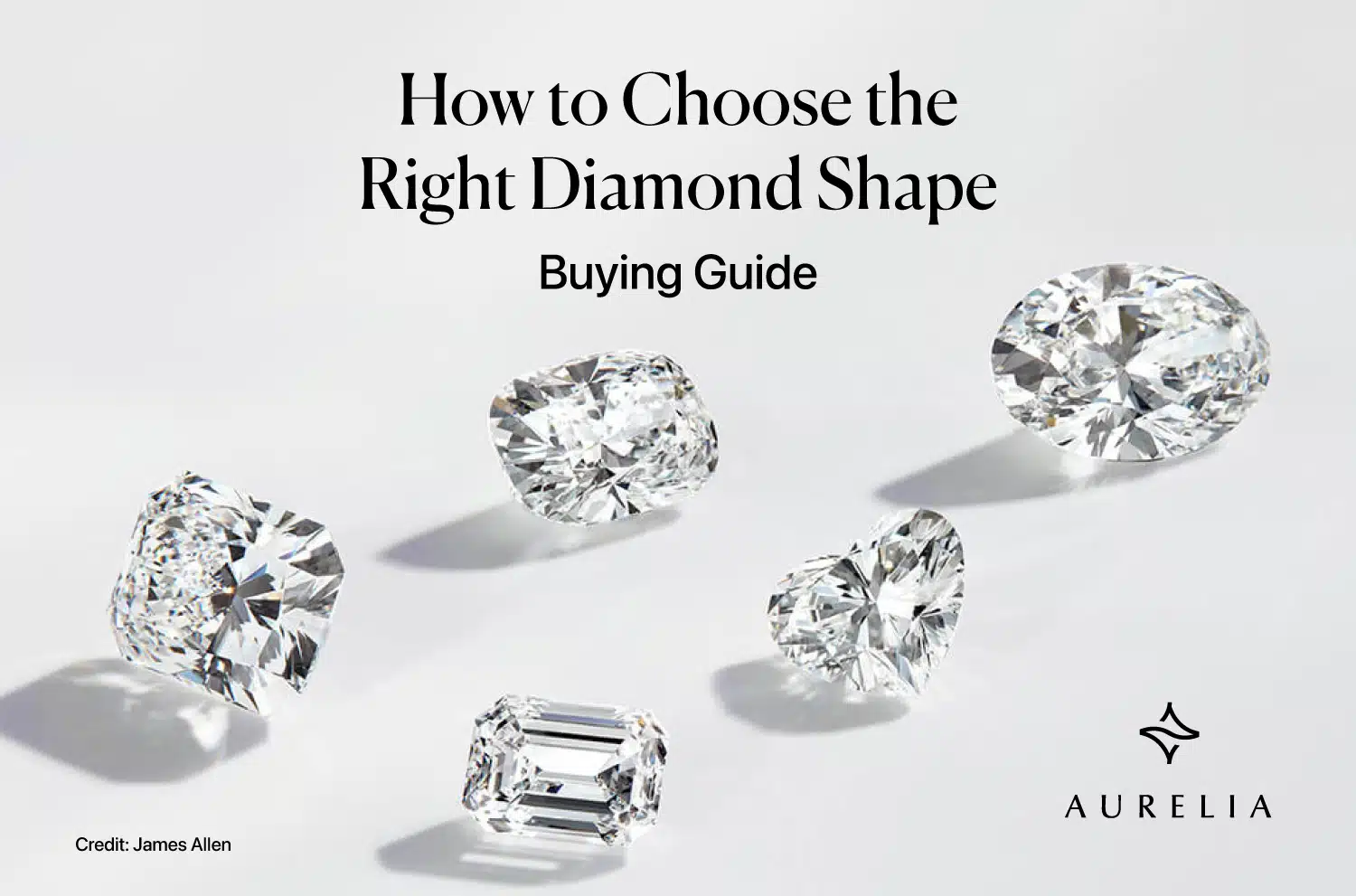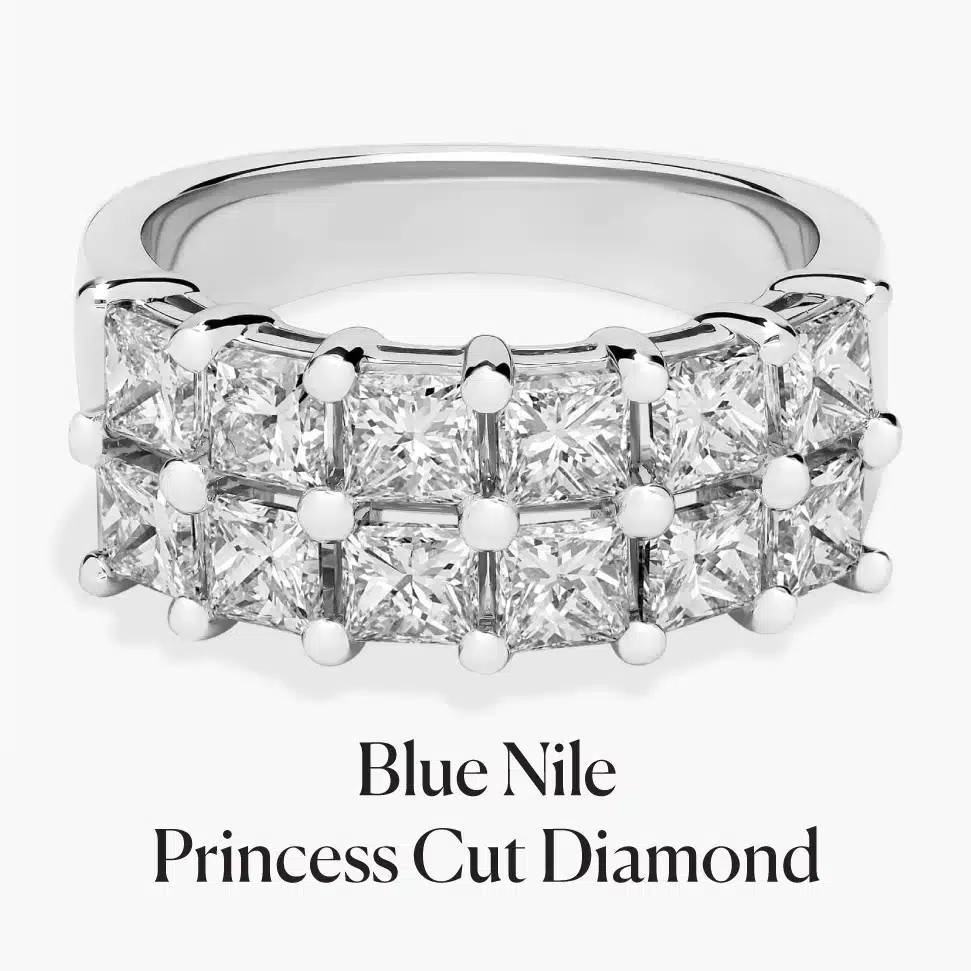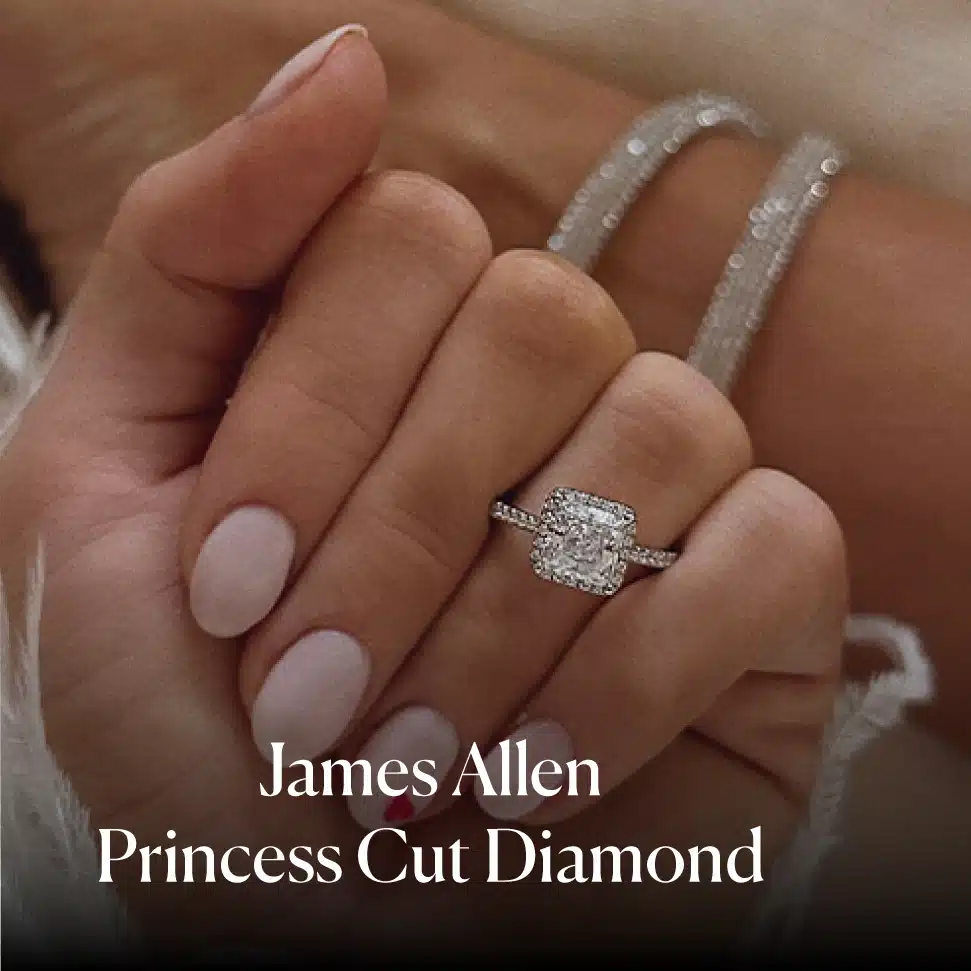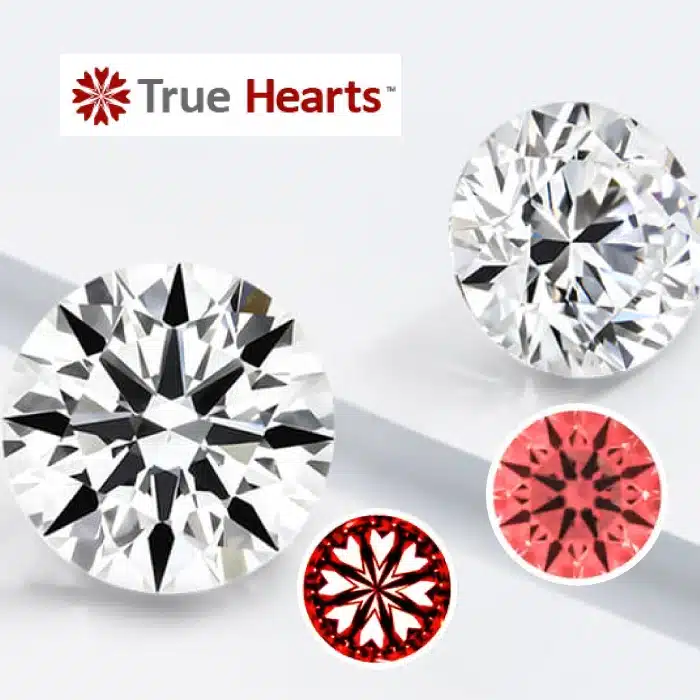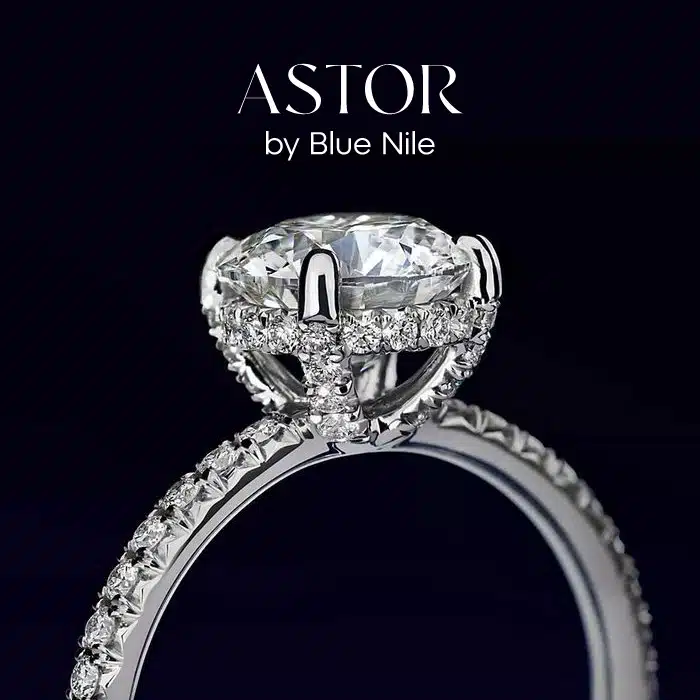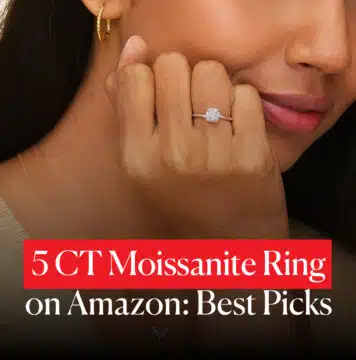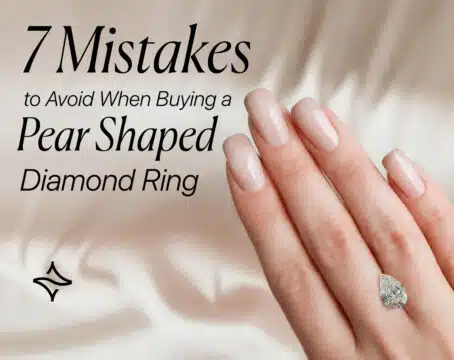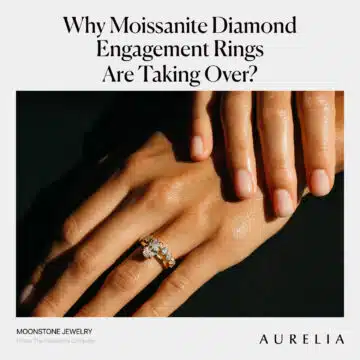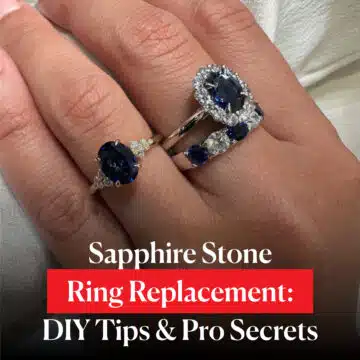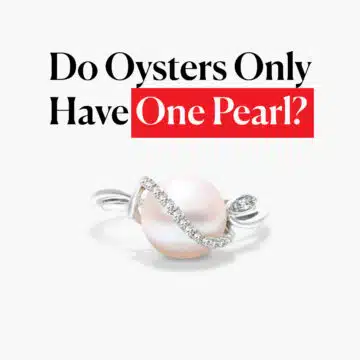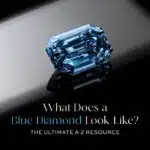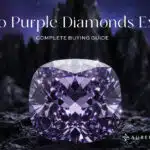Alright, let’s get into it. When you’re ready to buy a diamond, the very first and most personal choice you will make is its diamond shape. It’s the one thing you can’t grade on a chart or a lab report—it’s all about what speaks to your heart, your style, and the story you want to tell.
But let’s be honest, it also feels like a high-stakes choice, doesn’t it? You’re asking yourself, “Which one sparkles the most? Which one looks biggest for my money? What if I choose the wrong one?”
That’s why I wrote this guide.
We are going to go far beyond just showing you pretty pictures. In this definitive guide, we will do a deep, comprehensive dive into each of the 12 main diamond shapes. I’ll give you my unfiltered, insider’s take on the personality, sparkle profile, and smart buying strategies for every single one.
By the end of this, you’ll know exactly which diamond shape is right for you, and you’ll be able to choose it with total confidence.
- Diamond Shape vs. Diamond Cut: A Critical Difference We Must Cover First
- The Top 12 Diamond Shapes: A Comprehensive Breakdown
- For the Connoisseur: A Note on Rare & Antique Shapes
- The Value Maximizer Chart: Which Shapes Look Biggest for Your Budget?
- How Your Choice of Shape Affects Color and Clarity Grades
- Your Video Guide to Diamond Shapes
- My Final Advice Before You Buy
- Conclusion
- Frequently Asked Questions About Diamond Shapes
Diamond IQ Test: Natural or Lab-Grown?
Two identical diamonds: GIA Certified, 1.51ct, D Color, VVS1, Ideal Cut. One is natural ($16,530), the other is lab-grown ($2,390). Choose the diamond you like better and see if you can match it to its origin.
Diamond Shape vs. Diamond Cut: A Critical Difference We Must Cover First
Alright, before we go any further, we need to get one thing straight. This is where the industry loves to confuse people, and it’s where a lot of costly mistakes are made. I’m talking about the difference between a diamond’s Shape and its Cut.
Most people use the words interchangeably. You can’t. They mean two completely different things, and understanding this is the foundation of buying a smart diamond.
Here’s the simple breakdown:
- Shape is the outline: It’s the geometric form of the diamond when you look down at it. Round, Oval, Princess, and Pear are all shapes. It’s a matter of style and personal taste.
- Cut is the quality: This refers to the craftsmanship—the quality of the diamond’s angles, facets, and proportions. A diamond’s Cut grade determines how well it handles light, which is what gives it its fire and sparkle. It’s a measure of performance.
You can have a beautiful pear shape with a terrible cut that makes it look dull and lifeless.
Think of it like buying a car. The shape is whether you choose a sleek sports car, a practical SUV, or a classic sedan. The cut is the quality of the engine inside. A poorly cut diamond is like a Ferrari with a lawnmower engine—it might have a beautiful shape, but it’s not going to perform.
So, here’s my number one rule that applies to every single shape we’re about to discuss: you must always prioritize the highest Cut grade you can afford (that’s an “Excellent” or “Ideal” grade).
In this guide, we are focusing on the different shapes. But for each one, I’ll give you the crucial tips you need to ensure you’re getting a top-quality cut to go with it.
The Top 12 Diamond Shapes: A Comprehensive Breakdown
Alright, let’s get into the main event—the deep dive into each of the 12 core diamond shapes. This isn’t just a list; it’s an insider’s guide. For each shape, I’m going to give you my unfiltered take on its personality, its unique sparkle profile, the stats you need to know, and the kind of real-world examples that turn you into a confident, educated buyer.
1. Round Brilliant
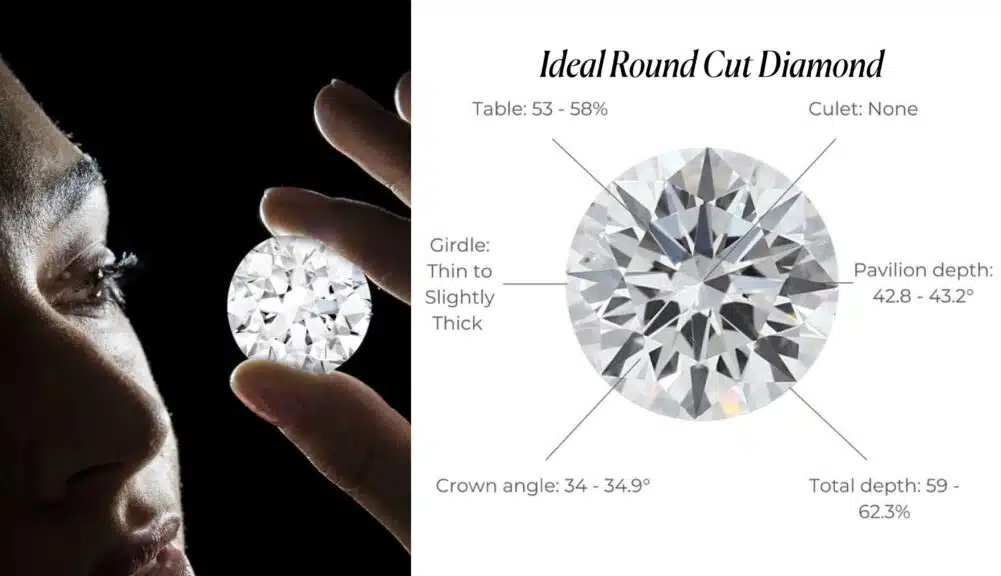
When we talk about an “Ideal” or “Excellent” cut for a Round Brilliant, we’re not just throwing words around. We’re talking about a precise, scientific recipe of angles and proportions, just like the ones you see in this chart. These numbers—the Table, the Depth, the Crown Angle—are the secret ingredients that determine how well a diamond can capture light, bend it, and shoot it back to your eye as that breathtaking sparkle you’re looking for.
You don’t need to memorize these numbers, but I want you to understand that they are the blueprint for the brilliance you’re paying for. A diamond cut to these exact specifications is a perfectly tuned light machine. This is the science behind the sparkle, and it’s why a top-quality cut is the one “C” you should never compromise on.
Personality: Timeless, Classic, The Benchmark for Brilliance.
Mehedi’s Take: The round brilliant is, and always will be, the undisputed king of diamond shapes. It accounts for over two-thirds of all diamonds sold, and for one simple reason: it is scientifically engineered for maximum sparkle.
In 1919, a diamond cutter and mathematician named Marcel Tolkowsky published his thesis on the ideal angles and proportions needed to create the most intense fire and brilliance.
His work perfected the 58-facet pattern that defines the modern round brilliant cut. It’s the standard by which all other shapes are judged.
This perfection, however, comes at a price. Creating a round brilliant wastes more of the original rough diamond (often 50-60%) than any other shape, and the cost of that wasted material is passed on to you, making it the most expensive shape per carat.
| Characteristic | Mehedi’s Tip |
| Ideal L/W Ratio | 1.00 – 1.03 (Perfectly Circular) |
| Hides Color? | Yes, exceptionally well. |
| Hides Inclusions? | Yes, the best of any shape. |
| Looks Bigger? | No, it’s the benchmark for size. |
Real-World Examples:
- Blue Nile: A 1.02 carat, H-Color, VS2-Clarity, Ideal Cut Round Diamond. This is a classic “sweet spot” stone, offering great value.
- James Allen: A 1.06 carat, G-Color, VS2-Clarity, True Hearts™ Cut Round Brilliant. This is a premium choice for those who want that top-tier, “hearts and arrows” sparkle. Learn more about True Hearts™ cut here.
Best Deal Of The Year – Final Days
Blue Nile’s “Clear The Vault” is ON.
Shop Fine Jewelry Upto 70% OFF.
*Exclusions may apply. See Blue Nile for complete details.
2. Princess Cut
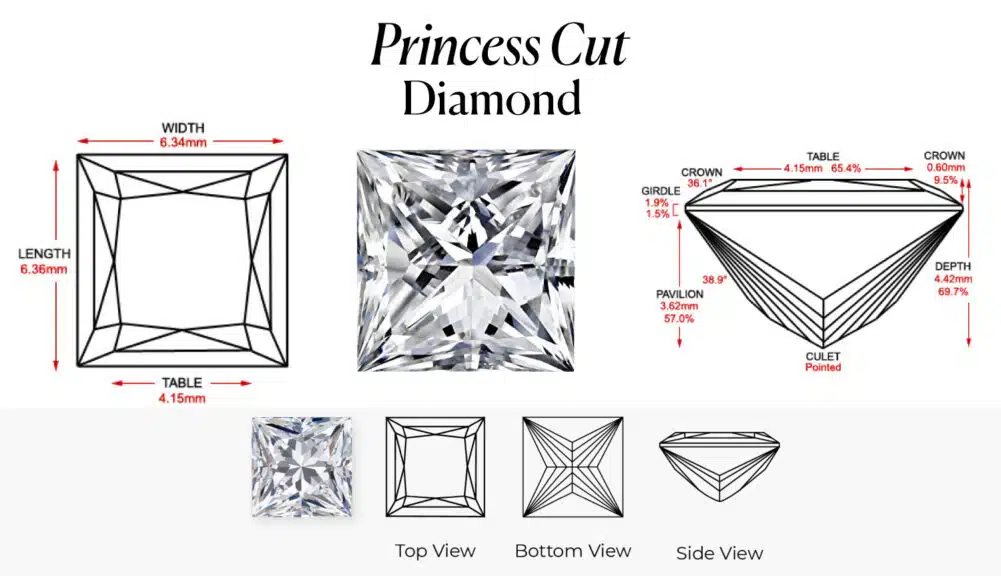
Now, let’s look at the blueprint for a Princess Cut diamond. This chart does a beautiful job of showing you exactly what goes into creating the modern, fiery sparkle that makes this shape so popular.
What I want you to pay close attention to is the “side view.” See how the bottom part of the diamond, the pavilion, forms a deep pyramid shape? That complex structure of facets is the engine that creates the dazzling “crushed ice” brilliance.
You can also see how perfectly square this example is, with its length and width being nearly identical. And just like with a round brilliant, all these numbers—the table percentage, the depth, the crown angle—are the crucial ingredients in the recipe for a truly spectacular diamond.
Understanding this anatomy is the key to appreciating why a well-cut Princess diamond is such a fantastic and valuable choice.
Personality: Modern, Fiery, Excellent Value.
Mehedi’s Take: The princess cut is the second most popular shape and the perfect choice for someone who loves the fire of a round diamond but wants a sharper, more modern, and contemporary look.
Its sparkle is brilliant and dazzling, often described as “crushed ice.” The single greatest advantage of the princess cut is its incredible value.
Its shape is a pyramid, which is very similar to the natural octahedral shape of a rough diamond crystal. This means cutters can retain a high percentage of the original diamond’s weight, resulting in less waste and a lower price-per-carat for you. It’s one of the best ways to get a big, fiery diamond for a very smart price.
| Characteristic | Mehedi’s Tip |
| Ideal L/W Ratio | 1.00 – 1.05 (For a perfect square) |
| Hides Color? | Fairly well, but can show in corners. |
| Hides Inclusions? | Very well. |
| Looks Bigger? | No, can look slightly smaller than a round. |
Real-World Examples:
- Blue Nile: A 1.02 carat, G-Color, VS1-Clarity, Ideal Cut Princess Diamond.
- James Allen: A 1.20 carat, H-Color, VS1-Clarity, Ideal Cut Princess Diamond, showcasing its fantastic value.
Sharp, modern, and full of sparkle—princess cut diamonds are a bold favorite for engagement rings and statement jewelry. At Blue Nile, you’ll find a carefully curated collection of certified princess cut diamonds, hand-selected for brilliance, quality, and value.
Whether you're looking for a classic solitaire or a diamond-accented setting, Blue Nile makes it easy to design your perfect ring. Plus, with up to 35% off select styles, now’s the perfect time to invest in elegance.
WHY SHOP BLUE NILE FOR PRINCESS CUT DIAMONDS?
- Thousands of certified princess cut diamonds with detailed grading reports
- Expertly crafted engagement ring settings in platinum or 14K/18K gold
- Real-time diamond consulting and virtual appointments available
- Up to 35% off on select diamond jewelry and engagement rings
- Free secure shipping, returns, and lifetime warranty on every purchase
- Trusted since 1999, with a reputation for quality, value, and service
SHOP PRINCESS CUT DIAMONDS AT BLUE NILE
Looking for a diamond that blends modern edge with timeless brilliance? Princess cut diamonds at James Allen are the perfect match. Known for their sharp angles, exceptional fire, and clean, square shape, these diamonds are a popular choice for engagement rings and fine jewelry.
James Allen offers one of the largest online selections of GIA-certified princess cut diamonds, all viewable in stunning 360° HD so you know exactly what you’re getting. With up to 35% off select styles, now is the best time to shop for a diamond that’s bold, brilliant, and beautifully priced.
WHY SHOP JAMES ALLEN FOR PRINCESS CUT DIAMONDS?
- Thousands of GIA-certified princess cut diamonds in all sizes and qualities
- High-resolution 360° video lets you view each diamond from every angle
- Customize your setting in gold or platinum with just a few clicks
- Up to 35% off select diamonds and engagement rings
- 30-day returns, free resizing, and lifetime warranty included
- 24/7 expert support and insured international shipping
3. Cushion Cut
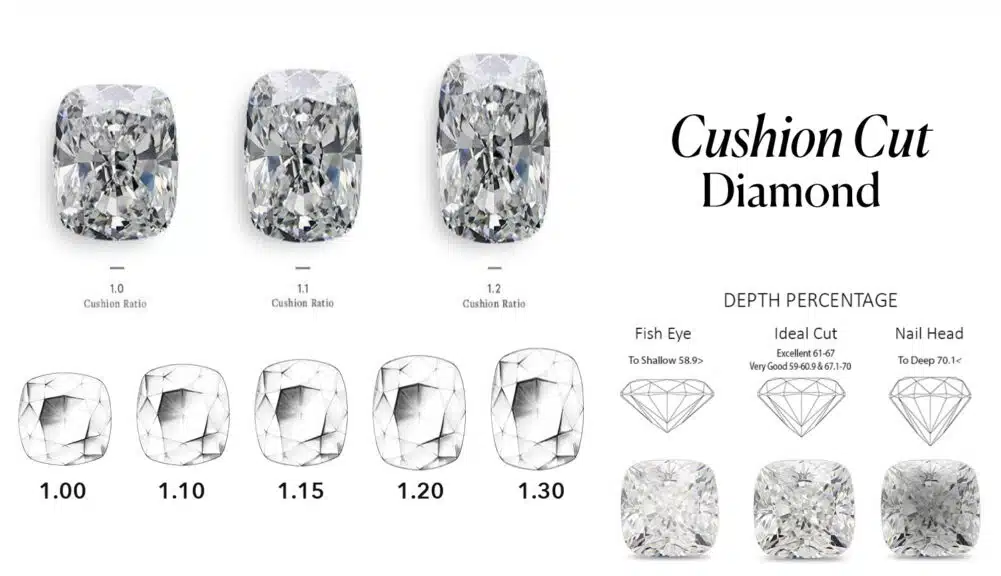
The Cushion Cut is one of the most romantic and timeless shapes, but it’s also one of the most complex. This fantastic chart is the perfect ‘cheat sheet’ to understanding what makes a truly great one.
First, look at the ratio. Do you prefer the classic, pillowy look of a perfect square (1.0), or the more modern, elongated rectangle (1.20+)? There’s no wrong answer; it’s all about personal style.
Now, and this is the most important part, look at the Depth Percentage chart. This is the insider’s secret to getting a brilliant cushion cut. If a cushion is cut too shallow, it will have a dead-looking “Fish Eye” in the center.
If it’s cut too deep, it will have a dark “Nail Head” that kills the sparkle. The “Ideal Cut” depth is that perfect sweet spot that allows the light to bounce around inside and come back to your eye as that beautiful “crushed ice” sparkle. This is the kind of chart that turns you into a truly savvy shopper.
Personality: Vintage, Romantic, Soft.
Mehedi’s Take: The cushion cut has been around for over 200 years and was once the most popular diamond shape. It’s a square or rectangular shape with soft, rounded corners, giving it a pillowy, romantic feel.
There are two main styles: the “antique” cushion with larger facets that produce bigger, chunkier flashes of light, and the modern “crushed ice” cushion with smaller facets that create a shower of scintillation.
It’s a timeless choice that has seen a massive surge in popularity for its blend of classic charm and modern sparkle.
| Characteristic | Mehedi’s Tip |
| Ideal L/W Ratio | 1.00 – 1.05 (Square); 1.15-1.20 (Rectangle) |
| Hides Color? | Yes, exceptionally well. |
| Hides Inclusions? | Very well. |
| Looks Bigger? | No, often looks smaller for its weight. |
Real-World Examples:
- Blue Nile: A 1.50 carat, H-Color, VS1-Clarity, Cushion Cut Diamond.
- James Allen: A 1.30 carat, I-Color, VS2-Clarity, Cushion Cut Diamond in a yellow gold setting.
DIAMOND ON SALE!!
⏰ Tick-Tock! The Best Diamond Deals at James Allen Are Disappearing Fast!
4. Emerald Cut
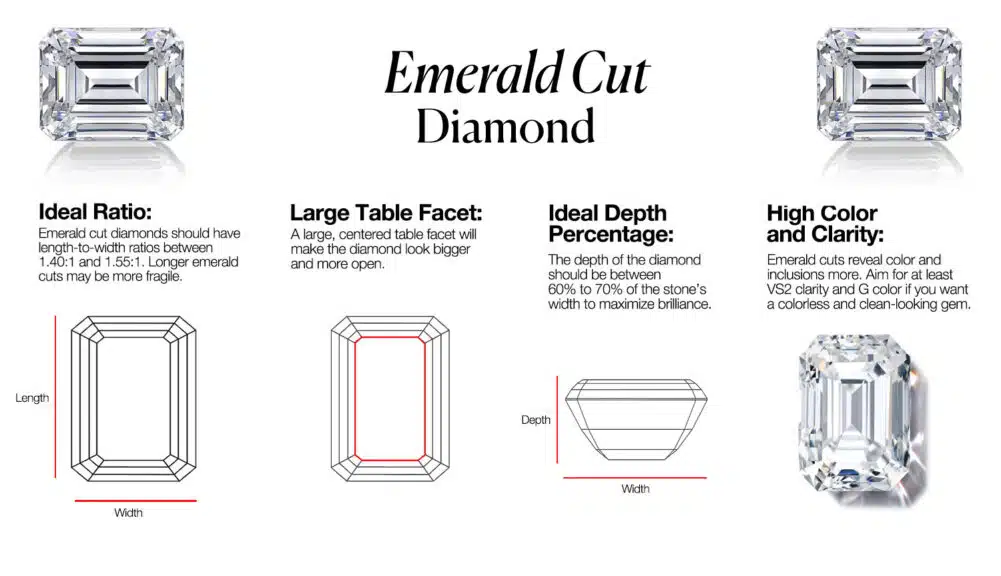
The Emerald Cut is the definition of sophisticated elegance, but it’s a shape that plays by its own rules. This chart is your perfect guide to what really matters when choosing one.
Forget what you know about other diamonds—with an emerald cut, Color and Clarity are everything. Look at the diagrams. See that large, open “table”? It’s like a big, clear window right into the soul of the diamond.
There’s nowhere for inclusions or a faint yellow tint to hide. This is why, as the chart points out, I always advise clients to aim for a clarity grade of VS2 or higher and a color grade of G or better for this specific shape.
Also, pay attention to the Ideal Ratio. A ratio of about 1.45 gives you that classic, beautifully balanced rectangular shape. This is how you find an Emerald cut that looks less like a square and more like a mesmerizing “hall of mirrors.”
Personality: Elegant, Sophisticated, Art Deco.
Mehedi’s Take: An emerald cut does not sparkle in the same way a round or princess cut does. Instead of a brilliant fire, it creates long, dramatic flashes of light in what gemologists call a “hall of mirrors” effect.
Its beauty is in its clean lines and its large, open table that showcases the diamond’s clarity like a clear, deep pool of water. It’s the choice for someone with a confident, understated, and sophisticated style.
It became immensely popular during the Art Deco period and has remained a symbol of elegance ever since.
| Characteristic | Mehedi’s Tip |
| Ideal L/W Ratio | 1.35 – 1.50 (Classic Rectangle) |
| Hides Color? | No, it shows color clearly. |
| Hides Inclusions? | No, it shows inclusions clearly. |
| Looks Bigger? | Yes, the large table creates a size illusion. |
Real-World Examples:
- Blue Nile: A 1.50 carat, G-Color, VS1-Clarity, Emerald Cut Diamond.
- James Allen: A 2.01 carat, H-Color, VS2-Clarity, Emerald Cut Diamond.
5. Oval Cut
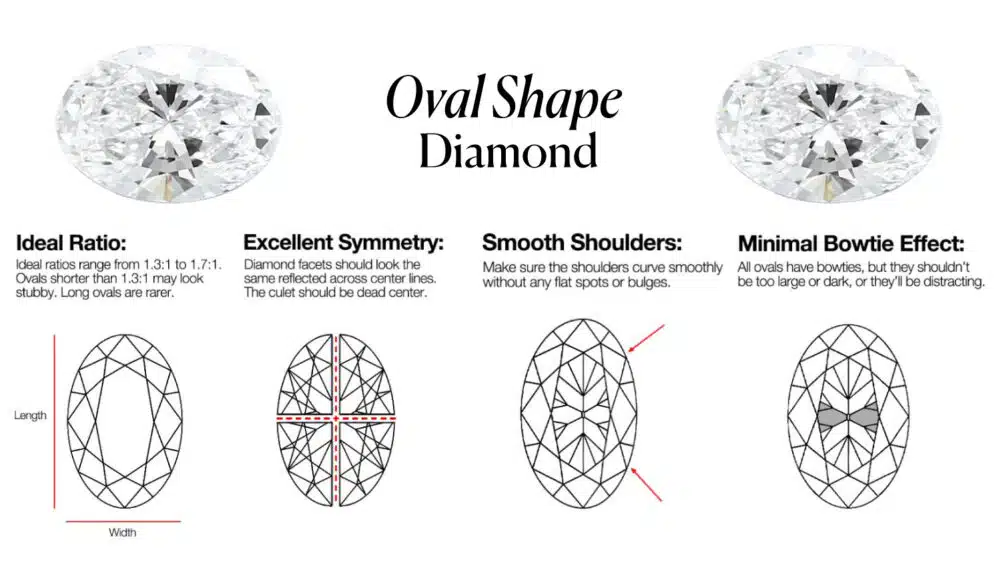
The Oval Shape Diamond is one of the hottest shapes on the market, and for good reason—it’s brilliant, it looks huge for its carat weight, and it’s incredibly elegant. But from my years in the business, I can tell you it’s also one of the trickiest shapes to buy right. This chart is your secret weapon.
Forget everything else for a moment and focus on that last point: the “Minimal Bowtie Effect.” Almost every oval has a slight shadow across its center that looks like a man’s bowtie. On a well-cut stone, it’s barely noticeable. On a poorly cut one, it’s a large, dark, distracting void that kills the sparkle. A GIA report will not tell you if a diamond has a bad bow-tie.
This is why my #1 rule for ovals is non-negotiable: you must see a 360° video before you buy. The diagrams for Symmetry and Smooth Shoulders are also crucial. When all four of these factors come together, you get an absolutely breathtaking diamond.
Personality: Trendy, Elegant, Finger-Flattering.
Mehedi’s Take: The oval cut is having a major moment, and for good reason. It offers the best of both worlds: you get the brilliant, fiery sparkle of a round diamond, but in an elongated shape that is both unique and incredibly flattering.
Ovals create a “finger-slimming” effect, making the hand appear more elegant. They also have a large surface area for their carat weight, meaning they often look bigger than a round diamond of the same size.
The one thing you must know about ovals is the “bow-tie” effect—a potential dark shadow across the center. A well-cut oval will have a minimal, almost invisible bow-tie, which is why seeing a 360° video is absolutely essential before buying.
| Characteristic | Mehedi’s Tip |
| Ideal L/W Ratio | 1.35 – 1.50 (A classic oval) |
| Hides Color? | Very well. |
| Hides Inclusions? | Very well. |
| Looks Bigger? | Yes, significantly. |
Real-World Examples:
- Blue Nile: A 1.50 carat, H-Color, VS2-Clarity, Oval Cut Diamond.
- James Allen: A 1.70 carat, G-Color, SI1-Clarity, Oval Cut Diamond.
6. Radiant Cut
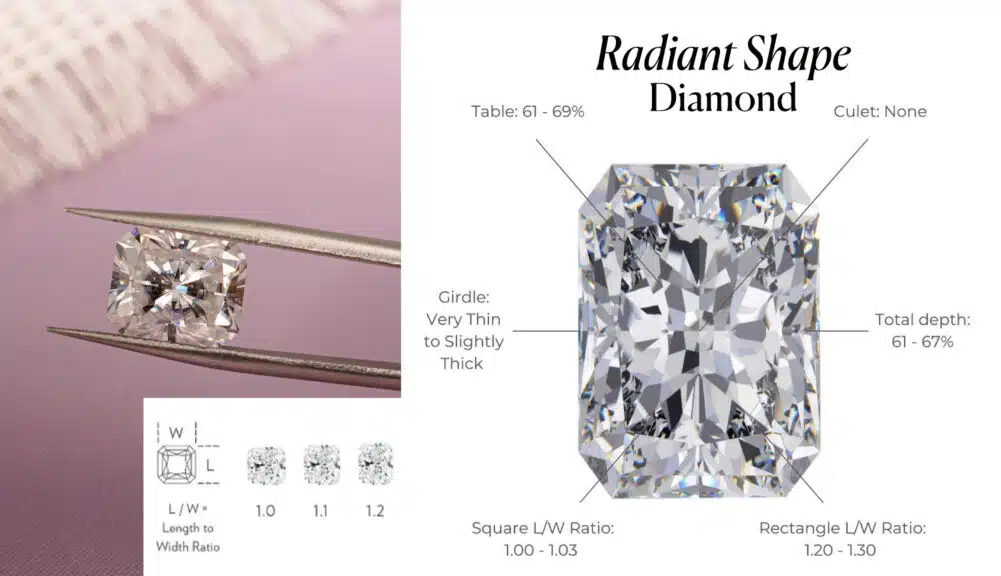
Let’s talk about the ultimate hybrid: the Radiant Shape Diamond. From my time in the trade, I can tell you this shape was specifically designed to give buyers the best of both worlds, and this chart shows you how.
It takes the long, elegant outline of an Emerald Cut but replaces the glassy step cuts with the fiery, brilliant-style faceting of a Round. The result is one of the most brilliant and dazzling of all the fancy diamond shapes, often called a “crushed ice” look.
What I want you to focus on here are the ratios. You can choose a classic square look (a 1.0 ratio) or a more elongated rectangle (a 1.25 ratio)—it’s all about personal preference.
Because of its 70 facets and that incredible sparkle, it’s also one of the best shapes for hiding inclusions, making it a fantastic value. The Radiant is the perfect choice for someone who loves the sophisticated shape of an Emerald cut but can’t live without that top-tier sparkle.
Personality: Dazzling, Vibrant, The “Best of Both Worlds”.
Mehedi’s Take: I call the radiant cut the ultimate hybrid. It was designed to combine the elegant, rectangular outline of an emerald cut with the intense, fiery brilliance of a round cut. With 70 facets, it’s one of the most brilliant of all the fancy shapes, giving off a stunning “crushed ice” effect that sparkles from every angle.
Its cropped corners make it more durable than a princess cut, and it’s a fantastic shape for hiding inclusions. It’s the perfect choice for someone who loves the classy shape of an emerald cut but simply cannot give up that top-tier sparkle.
| Characteristic | Mehedi’s Tip |
| Ideal L/W Ratio | 1.00-1.05 (Square); 1.20-1.30 (Rectangle) |
| Hides Color? | Yes, very well. |
| Hides Inclusions? | Yes, exceptionally well. |
| Looks Bigger? | True to size. |
Real-World Examples:
- Blue Nile: A 1.50 carat, G-Color, VS1-Clarity, Radiant Cut Diamond.
- James Allen: A 2.01 carat, H-Color, SI1-Clarity, Radiant Cut Diamond.
Read Our 5-Star Blue Nile Review
Check our comprehensive Blue Nile review to learn why we rated Blue Nile 5 stars for their exceptional quality and value.
7. Asscher Cut
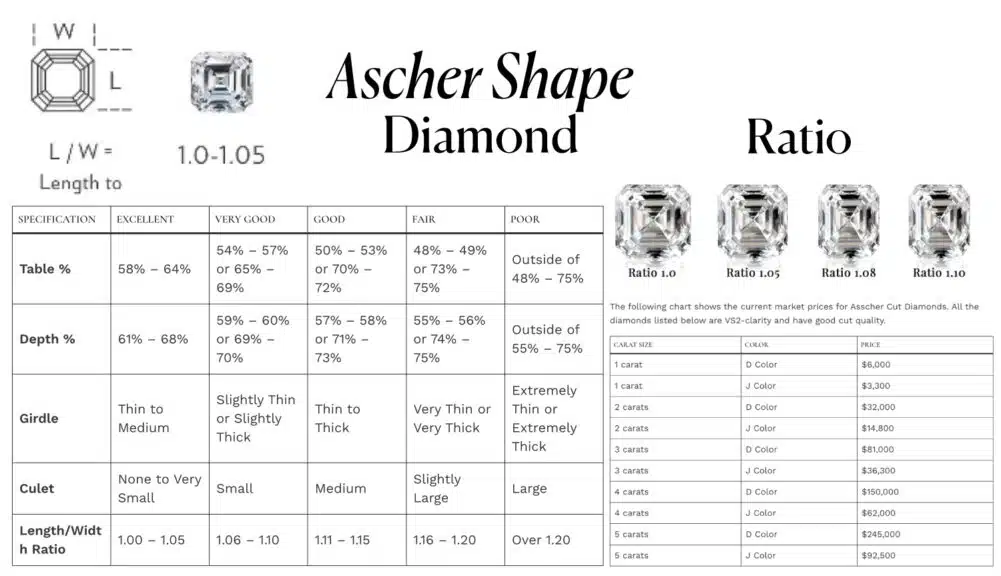
The Asscher Shape is for the true connoisseur. It’s a statement of vintage, Art Deco elegance, and this fantastic chart is the ‘insider’s cheat sheet’ to buying a great one.
Here’s what I want you to notice. First, look at the “Specification” table. This is your guide to the diamond’s cut quality. To get that mesmerizing, ‘hall-of-mirrors’ effect, you want a stone that falls squarely in that “Excellent” column—a depth between 61-68% and a table between 58-64% is the sweet spot.
Next, look at the price chart. This is a powerful lesson in how color dramatically affects the price of a step-cut diamond. See how a 1-carat, J-color Asscher is around $3,300, while the D-color is almost double that at $6,000? That’s because the Asscher’s clear facets act like a window, making color (or the lack thereof) very noticeable.
Use this chart as your blueprint. Stick to the “Excellent” specs, and choose the highest color grade your budget will allow. That’s the secret to finding an absolutely stunning Asscher cut.
Personality: Art Deco, Vintage, Mesmerizing.
Mehedi’s Take: The Asscher cut is a true piece of vintage history. It’s essentially a square emerald cut, with large step facets and dramatically cropped corners that create a unique, almost octagonal outline.
Like the emerald cut, its beauty is in its deep, mesmerizing “hall of mirrors” effect, not a fiery sparkle. An Asscher cut is a statement of sophisticated, old-world style. It was a hallmark of the Art Deco era. Because of its open, clear facets, it is not forgiving of flaws.
This is a shape where you should prioritize high clarity (VS2 or better) and color (H or better) to truly appreciate its unique beauty.
| Characteristic | Mehedi’s Tip |
| Ideal L/W Ratio | 1.00 – 1.05 (Perfectly Square) |
| Hides Color? | No, it shows color clearly. |
| Hides Inclusions? | No, it shows inclusions clearly. |
| Looks Bigger? | No, the deep cut makes it look smaller. |
Real-World Examples:
- Blue Nile: A 1.61 carat, G-Color, VS1-Clarity, Asscher Cut Diamond.
- James Allen: A 1.51 carat, H-Color, VS1-Clarity, Asscher Cut Diamond.
Best Deal Of The Year – Final Days
Blue Nile’s “Clear The Vault” is ON.
Shop Fine Jewelry Upto 70% OFF.
*Exclusions may apply. See Blue Nile for complete details.
8. Marquise Cut
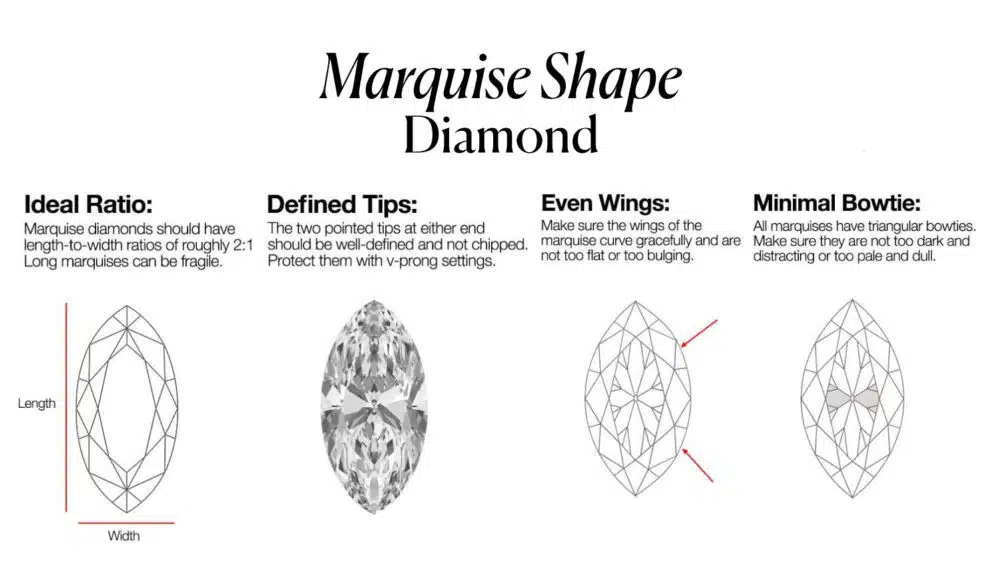
Let’s talk about the Marquise Shape Diamond, a cut with a dramatic royal history. Legend has it King Louis XV of France commissioned it to be designed in the shape of his mistress’s smile! It’s a truly stunning shape, but from my time in the trade, I can tell you it’s one of the most difficult to get right. This chart is your non-negotiable checklist.
I want you to burn that last point into your memory: “Minimal Bowtie.” Almost every marquise has a shadow across its center that looks like a man’s bowtie. On a well-cut stone, it’s a slight flicker. On a poorly cut one, it’s a giant, dark dead spot that completely kills the diamond’s brilliance.
The GIA report will not grade the bowtie. This is why my #1 rule for marquises is simple: you must see a 360-degree video before you buy. Use this chart. Check for even wings, make sure the tips are perfect, and most importantly, hunt for a minimal bowtie.
When you find one with all these elements, you’ve found a spectacular diamond that will look bigger than any other shape of the same carat weight—and that’s the magic of the marquise.
Personality: Dramatic, Unique, Regal.
Mehedi’s Take: The marquise cut has a legendary royal history. King Louis XV of France commissioned it to be designed in the shape of his mistress’s mouth. Its dramatic, elongated shape with two sharp points creates the largest surface area of any diamond shape.
This means a marquise cut will look significantly larger on the finger than a round diamond of the exact same carat weight, making it a fantastic choice for maximizing visual size. The two points can be vulnerable, so they must be protected by V-shaped prongs in the setting.
Like the oval, it’s essential to view a video to ensure it doesn’t have a distracting bow-tie effect.
| Characteristic | Mehedi’s Tip |
| Ideal L/W Ratio | 1.85 – 2.10 (Classic slender look) |
| Hides Color? | Fairly well, but can show at points. |
| Hides Inclusions? | Very well. |
| Looks Bigger? | Yes, the largest-looking of all shapes. |
Real-World Examples:
- Blue Nile: A 1.01 carat, H-Color, VS2-Clarity, Marquise Cut Diamond.
- James Allen: A 3.00 carat, G-Color, VS1-Clarity, Marquise Cut Diamond.
9. Pear Shape
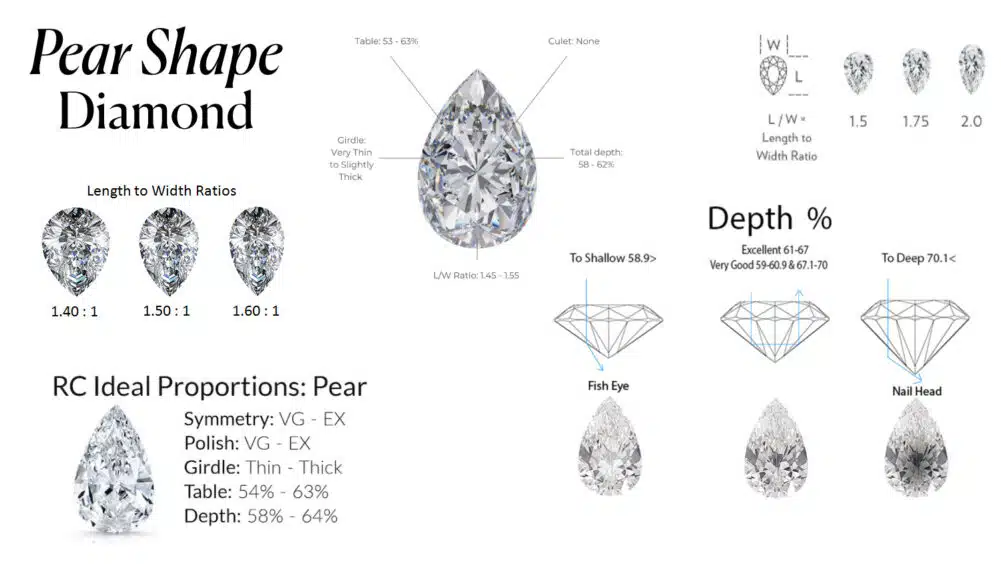
The Pear Shape is pure elegance. It’s a beautiful hybrid that combines the brilliant sparkle of a round with the unique character of a marquise, creating a timeless teardrop shape that is incredibly flattering on the finger.
But like other fancy shapes, getting a great one means paying attention to the details, and this chart is your perfect guide.
The two things I always tell my clients to focus on are the Length to Width Ratio and the Depth Percentage. As you can see, the L/W ratio is a matter of style—do you prefer a wider teardrop (1.40) or a more dramatic, slender one (1.60)? There’s no wrong answer.
However, the Depth Percentage is a matter of quality. Just like with a cushion cut, a pear that’s too shallow will look dead and glassy (a “Fish Eye”), and one that’s too deep will look dark and dull (a “Nail Head”).
That “Ideal Cut” range is the sweet spot that ensures your diamond will be a brilliant, fiery performer. Use these tips, and you’ll find a spectacular pear shape.
Personality: Elegant, Graceful, Unique.
Mehedi’s Take: Also known as the “teardrop” shape, the pear is a beautiful and elegant hybrid of a round brilliant and a marquise. It has a single sharp point and a gracefully rounded end, creating a distinctive and asymmetrical look.
This shape is incredibly flattering, as its elongated form makes the wearer’s finger appear longer and more slender. It has a brilliant facet pattern that gives it fantastic sparkle and fire, and like other elongated shapes, it tends to look larger for its carat weight.
Symmetry is absolutely critical for a pear shape—the point must line up perfectly with the apex of the rounded end.
| Characteristic | Mehedi’s Tip |
| Ideal L/W Ratio | 1.45 – 1.75 (Classic teardrop) |
| Hides Color? | Fairly well, but can show at the tip. |
| Hides Inclusions? | Very well. |
| Looks Bigger? | Yes. |
Real-World Examples:
- Blue Nile: A 2.01 carat, G-Color, VS2-Clarity, Pear Shaped Diamond.
- James Allen: A 1.97 carat, H-Color, VS1-Clarity, Pear Shaped Diamond.
James Allen: Our 5-Star Choice for Price and Selection
Check our comprehensive James Allen Review to learn more about their pricing and commitment.
10. Heart Shape
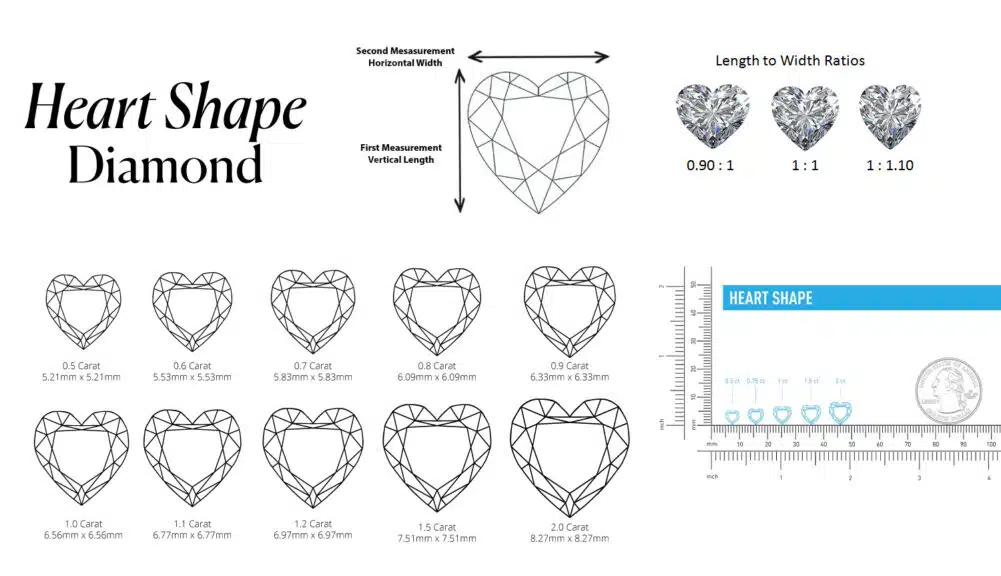
Let’s talk about the ultimate symbol of love: the Heart Shape Diamond. This isn’t just a diamond; it’s a statement. But from my experience, a great heart shape is a game of millimeters, and this chart shows you exactly what to look for.
The most critical factor for a heart is its Length-to-Width Ratio. As you can see, the ideal ratio is a perfectly balanced 1:1, which gives you that classic, beautiful heart outline. A ratio of 1:1.10 will give you a more elegant, elongated look, while a 0.90:1 ratio will be a bit chubbier and wider.
Also, look at the carat size chart. What’s my insider advice? I always tell clients to aim for one carat or larger for this particular shape. In smaller sizes, like the 0.5-carat example, it can be difficult for the naked eye to clearly make out that iconic heart outline, especially once prongs are added.
For a heart, you want that beautiful, sentimental shape to be instantly recognizable and celebrated.
Personality: Romantic, Sentimental, Bold.
Mehedi’s Take: The heart shape is the ultimate symbol of love, a bold and unmistakable choice. It’s essentially a pear-shaped diamond with a cleft cut into the rounded end.
This is one of the most difficult and complex shapes to cut well, and perfect symmetry is non-negotiable—the two lobes of the heart must be perfectly balanced.
Because the unique shape can be hard to perceive in smaller sizes, I always recommend choosing a heart shape that is at least one carat or larger. It is a sentimental and truly romantic choice for a confident wearer who wants their ring to tell a story.
| Characteristic | Mehedi’s Tip |
| Ideal L/W Ratio | 0.95 – 1.05 (Classic heart look) |
| Hides Color? | Fairly well. |
| Hides Inclusions? | Very well. |
| Looks Bigger? | True to size. |
Real-World Examples:
- Blue Nile: A 1.01 carat, G-Color, VS1-Clarity, Heart Shaped Diamond.
- James Allen: A 1.71 carat, H-Color, VS1-Clarity, Heart Shaped Diamond.
Lifetime Protection Alert!
A James Allen purchase includes a free lifetime warranty. This covers free prong tightening, polishing, and cleaning for life, ensuring your jewelry always looks its best.
11. Baguette Cut

Let’s talk about the unsung hero of the diamond world: the Baguette Shape Diamond. As this excellent chart shows, the baguette is all about clean lines and understated, glassy elegance.
You’ll almost never see a baguette as a center stone. Instead, it plays the perfect supporting role. Look at the two main types: the Rectangular and the Tapered.
Jewelers use these like architectural building blocks, often placing them on either side of a larger center stone—like an Emerald or Asscher cut—to create a stunning, geometric, Art Deco look.
Because of its long, open “step-cut” facets, which you can see in the side profile diagram, a baguette doesn’t sparkle like a brilliant cut. Its beauty is in its clarity and luster. This is why, if you’re choosing a ring with baguettes, it’s crucial to make sure they are high-clarity stones (VS2 or better).
They are the perfect way to add a touch of structured, sophisticated glamour to any piece.
Personality: Art Deco, Structured, Sleek.
Mehedi’s Take: Now we’re talking about the ultimate “supporting actor” in the diamond world. Baguette diamonds are rarely the star of the show. Instead, these are long, slender, rectangular diamonds with step cuts (like an emerald cut).
Their primary role is as elegant side stones, often flanking a larger center stone in a three-stone ring. Their clean, geometric lines create a beautiful, structured look that was a hallmark of the Art Deco period.
Because their open facets showcase clarity so well, it’s crucial to choose baguettes with a clarity grade of VS2 or higher, as any inclusion would be quite noticeable.
| Characteristic | Mehedi’s Tip |
| Role | Primarily side stones |
| Hides Color? | No, shows color clearly. |
| Hides Inclusions? | No, shows inclusions clearly. |
| Best For | Adding a structured, Art Deco look. |
Real-World Examples:
- Blue Nile: Emerald Cut engagement ring with Baguette side stones.
- James Allen: Solitaire enhancer ring with Baguettes.
Best Deal Of The Year – Final Days
Blue Nile’s “Clear The Vault” is ON.
Shop Fine Jewelry Upto 70% OFF.
*Exclusions may apply. See Blue Nile for complete details.
12. Trillion Cut
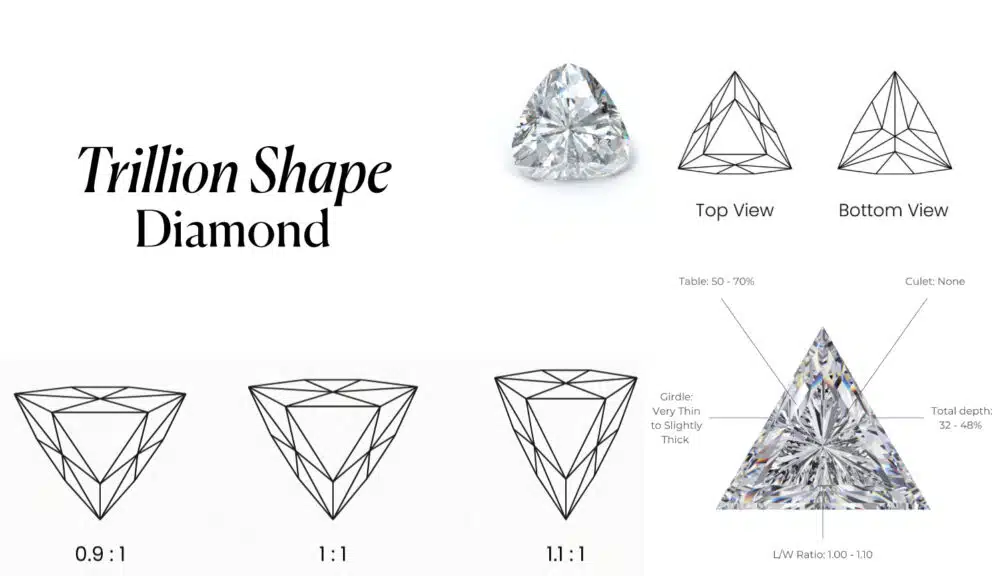
Let’s talk about the boldest of the bunch: the Trillion Shape Diamond. This is a shape for someone who is confident and wants a brilliant, modern, and truly unique look. As you can see from this fantastic guide, the trillion’s beauty is all in its geometry.
My number one piece of advice when looking at a trillion is to check the Length-to-Width Ratio. The classic trillion is a perfect equilateral triangle with a 1:1 ratio, which you can see in the bottom-left of the chart. It’s a balanced and powerful look.
More importantly, remember that those three sharp points are its most vulnerable feature. If you choose a trillion, it is absolutely essential that it is placed in a protective setting—either with a full bezel or, at a minimum, with V-shaped prongs that cover and shield those tips from chipping.
With its incredible fire and huge “spread” (it looks much larger than its carat weight!), a well-protected trillion is one of the most dazzling and impressive shapes you can choose.
Personality: Bold, Modern, Dazzling.
Mehedi’s Take: The trillion, or trilliant, cut is one of the most unique and daring diamond shapes you can choose. It’s a triangular shape that can be used in two main ways. As side stones, two trillions can beautifully frame a center stone, adding a fiery, modern flair to a ring.
As a center stone itself, a trillion is an incredibly bold statement piece. Its large, flat table gives it an immense “spread,” meaning it tends to look much larger than other shapes of the same carat weight.
However, its three sharp points are vulnerable to chipping, so it absolutely must be set in a protective setting, like a bezel or a V-pronged design.
| Characteristic | Mehedi’s Tip |
| Role | Center or side stones |
| Hides Color? | Fairly well. |
| Hides Inclusions? | Very well, but avoid corners. |
| Looks Bigger? | Yes, significantly. |
Real-World Examples:
- Blue Nile: Princess Cut engagement ring with Trillion side stones.
- James Allen: Custom design-a-ring with a loose Trillion diamond.
For the Connoisseur: A Note on Rare & Antique Shapes
Alright, we’ve covered the modern classics—the top 12 shapes that make up the vast majority of the market today. But for those of us who love history, who are fascinated by the story a piece of jewelry tells, there’s another world of shapes to explore.
Let’s touch on a couple of rare, antique cuts you might encounter in a vintage jewelry shop or an estate sale. These aren’t just diamonds; they are time capsules.
The Old European Cut
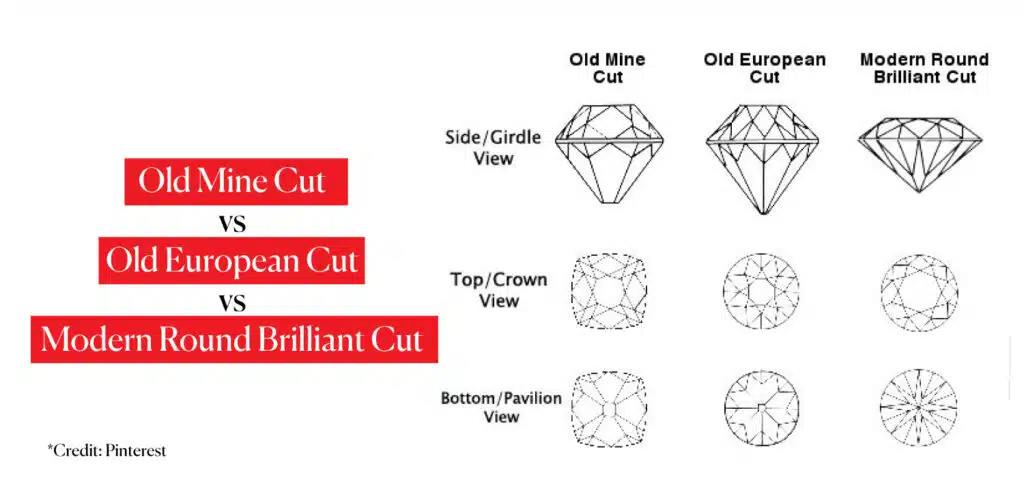
Mehedi’s Take: Ever wonder why your grandmother’s or great-grandmother’s engagement ring seems to sparkle differently than modern rings? It’s not your imagination. You are likely looking at an Old European Cut.
This shape was the direct precursor to the modern Round Brilliant, popular from the late 1800s through the 1930s. It was cut by hand, by a master craftsman’s eye, with one goal: to look absolutely mesmerizing in the soft, romantic glow of candlelight and gas lamps.
It has a completely different personality than a modern round. You’ll notice it has:
- A smaller table (the top facet).
- A higher crown (the upper portion).
- Thicker, chunkier facets.
- An open culet (a small, visible circle at the very bottom of the diamond).
The result is not the fiery, “crushed ice” sparkle of a modern brilliant. Instead, an Old European Cut produces broader, bolder flashes of light and a deep, warm, and incredibly romantic glow.
When you buy an “Old Euro,” you’re not just buying a diamond—you are buying a genuine piece of history, crafted by hand to dance in the light of a world gone by.
DIAMOND ON SALE!!
⏰ Tick-Tock! The Best Diamond Deals at James Allen Are Disappearing Fast!
The Rose Cut
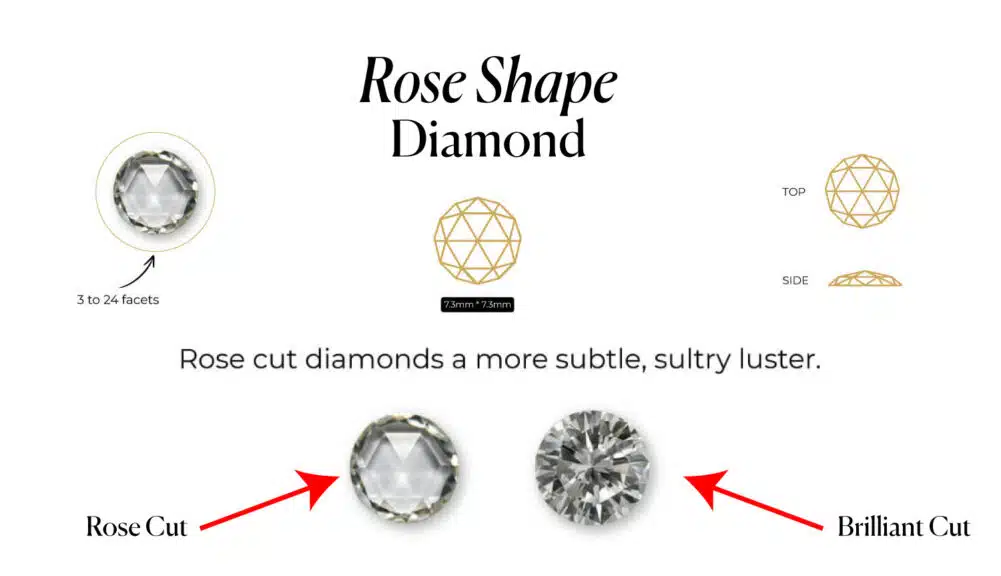
Let’s take a trip back in time and talk about one of the most romantic and soulful cuts you’ll ever see: the Rose Shape Diamond. This chart perfectly illustrates why it’s so different from the modern diamonds we’re used to.
Look at the side view. A rose cut has a completely flat bottom and a domed top covered in triangular facets, designed to look like a rosebud. This is the complete opposite of a modern brilliant cut with its deep, pointed pavilion.
As you can see in the side-by-side comparison, this means a rose cut doesn’t produce that explosive, fiery sparkle. Its beauty is in its soft, watery, and subtle shimmer. From my experience, it’s a “glows-more-than-it-flashes” kind of diamond.
Choosing a rose cut is for the true connoisseur of antique style—it’s a piece of history that wears its heart on its sleeve, offering a unique charm you simply cannot find in a modern stone.
Mehedi’s Take: Now we go even further back in time. The Rose Cut, which dates back to the 16th century and was immensely popular in the Georgian and Victorian eras, is one of the most romantic and subtle cuts you will ever see.
It’s fundamentally different from a modern diamond. It has a completely flat bottom and a domed top that is covered in triangular facets, designed to look like the spiraling petals of a rosebud.
Because it has no pavilion (the pointed bottom part of a modern diamond), a rose cut doesn’t produce the fiery, brilliant sparkle you’re used to. It can’t bounce light back to your eye in the same way. Instead, its beauty is in its soft, gentle, and almost watery shimmer. It glows more than it flashes.
A rose cut diamond is the choice for the true antique lover who values the soul and history of a piece above all else. It’s an understated, organic, and incredibly romantic look that feels completely different from anything made today. It’s less about brilliance and all about charm.
True Hearts is James Allen's collection for the visual perfectionist. These diamonds represent the top 1% of all diamonds graded for cut quality, specifically screened for flawless optical symmetry—what the industry calls "Hearts and Arrows." From my professional standpoint, this is as close to a perfectly cut diamond as you can get, and James Allen gives you the tools to see it for yourself.
WHAT WE LOVE ABOUT THIS COLLECTION:
- Verifiable Hearts & Arrows Pattern: The ultimate visual proof of a masterfully cut round diamond.
- Advanced Imaging Included: ASET and Idealscope images are provided to let you analyze the light performance like a pro.
- AGS "Ideal" Certification: Many True Hearts diamonds carry the coveted AGS Ideal grade—the industry's most stringent for cut.
- Unmatched Visual Scrutiny: Combines the Hearts & Arrows precision with James Allen's best-in-class 360° HD videos.
- Empowers the Buyer: You don't just have to trust a report; you get the visual evidence to confirm the diamond's superior brilliance.
- Guaranteed Eye-Clean Perfection: These stones are hand-selected to be free of any distracting inclusions to the naked eye.
The Value Maximizer Chart: Which Shapes Look Biggest for Your Budget?
Alright, let’s talk about one of the most important insider secrets in the diamond world. The industry prices diamonds based on their carat weight, but what you and I actually see and admire is a diamond’s visual size.
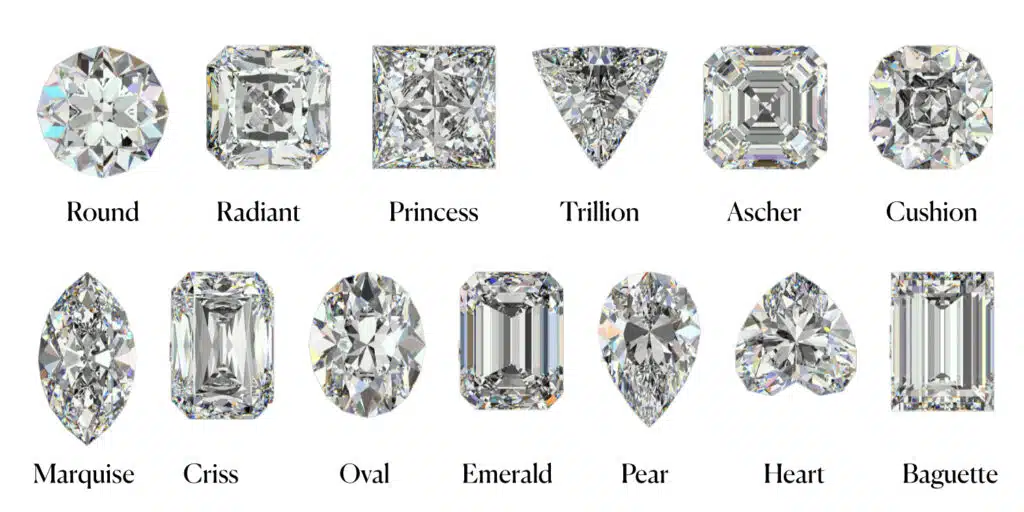
And those two things are not the same.
The way a diamond is cut and shaped can dramatically affect how large it looks “face-up” on your finger. An elongated shape with a shallow cut will look much bigger than a deep, square stone of the exact same carat weight.
If your primary goal is to get a diamond that looks as large and impressive as possible for your budget, this is the most important chart in this guide. This is how you maximize value.
| Shape | Looks Bigger or Smaller than Round? | Approx. Price Discount vs. Round | Mehedi’s Take |
| Marquise | Significantly BIGGER | -15% to -30% | The undisputed king of “finger coverage” and visual size. |
| Pear | Bigger | -10% to -25% | Elegant, and the elongated shape creates a large visual size. |
| Oval | Bigger | -10% to -25% | The current trendy choice for a reason—it looks huge. |
| Emerald | Slightly Bigger | -15% to -30% | The large “window” of its table creates a powerful size illusion. |
| Trillion | Bigger | -20% to -35% | Its wide, triangular shape offers an impressive spread. |
| Round | The Benchmark | Benchmark | The standard by which all other shapes are judged for size. |
| Radiant | True to Size | -20% to -30% | A fairly deep cut means it looks true to its carat weight. |
| Heart | Slightly Smaller | -15% to -25% | The clefts in the shape can make it appear slightly smaller. |
| Cushion | Smaller | -25% to -40% | Often cut deep to maximize brilliance, which hides carat weight. |
| Princess | Slightly Smaller | -25% to -40% | Can be a deep cut, but it’s an incredible value play for carat weight. |
| Asscher | Smallest | -25% to -40% | The deepest cut of all; looks smallest for its weight but has a unique charm. |
The Mehedi Breakdown:
Look at that chart closely. An Oval, Pear, or Marquise cut diamond will not only cost you significantly less than a Round Brilliant of the same carat weight, but it will actually look larger on your finger.
This is what I call the “Value Maximizer’s secret weapon.” You can choose a 1.2-carat Oval diamond that costs the same as a 1.0-carat Round diamond, and the Oval will look even bigger than the Round it’s being compared to.
You are simultaneously saving money and getting a more impressive visual impact. If you want to learn more about this strategy, I have a whole article dedicated to it: What Shape Diamond Looks the Largest?
This is how you use your knowledge of diamond shapes to be a smarter shopper.
Astor by Blue Nile is the collection for the data-driven buyer who demands scientific proof of performance. These diamonds are selected from the top 0.1% of Blue Nile's massive inventory, representing the most elite stones they offer. The collection's foundation is a unique dual-certification system that removes all guesswork, providing objective, third-party validation of a diamond's sparkle.
WHAT WE LOVE ABOUT THIS COLLECTION:
- Exclusive Dual Certification: Every diamond includes a GIA report plus a GemEx Light Performance report.
- Scientific Brilliance Scores: The GemEx report provides objective, numerical scores for Brilliance, Fire, and Sparkle.
- Ultimate Curation: Represents the absolute pinnacle of Blue Nile's inventory—only one in a thousand diamonds makes the cut.
- Guaranteed Performance: The strict vetting process guarantees an elite level of light performance, backed by data.
- The "Peace of Mind" Purchase: Perfect for buyers who want the proven best without needing to become a gemology expert themselves.
- Backed by Blue Nile's Upgrade Program: Your Astor diamond's full value can be applied toward a future upgrade.
How Your Choice of Shape Affects Color and Clarity Grades
Alright, let’s go a level deeper. This is an insider’s tip that can save you a serious amount of money and help you choose a truly spectacular diamond.
A diamond’s shape doesn’t just affect its style and how big it looks; it dramatically changes how it shows color and hides inclusions. Understanding this is the key to spending your budget where it matters most for your chosen shape.
Shapes That HIDE Color (And Save You Money)
Some facet patterns are brilliant at chopping up light and scrambling it around, which makes it very difficult for your eye to perceive any faint, underlying yellow tint. These are what I call the “forgiving” shapes.
- Round Brilliant: The undisputed champion. Its intense fire and brilliance are so powerful that they can make a lower color grade look incredibly white.
- Brilliant-Style Cushions, Radiants, Ovals, Pears, and Princesses: These “crushed ice” styles also do a fantastic job of masking color.
Your Smart-Buy Strategy: For any of these shapes, you can confidently shop in the H or even I color range and still get a diamond that looks icy-white once it’s set in a ring, especially in yellow gold.
Why pay for a D color grade you can’t see? Save the money and put it towards a higher carat weight or a better cut.
Shapes That SHOW Color (Where You Need to Invest)
On the other hand, some shapes act like big, clear windows, and there’s nowhere for color to hide. These are the “unforgiving” shapes.
- Emerald Cut & Asscher Cut: These step cuts have long, open facets that were designed to showcase a diamond’s clarity and cool, icy elegance. They do not have the fiery sparkle that masks color. Any hint of yellow will be noticeable.
Your Smart-Buy Strategy: If you’re in love with the sophisticated, Art Deco look of an Emerald or Asscher cut, you need to invest more in a high color grade. For these shapes, I strongly advise staying in the G color range or higher to ensure you get that crisp, white appearance they are famous for.
How Shape Affects Clarity
The exact same principle applies to clarity—a diamond’s natural “birthmarks.”
- Shapes that HIDE Inclusions: The brilliant facet patterns of the Round, Cushion, Radiant, Princess, Oval, and Pear are fantastic at hiding small inclusions. The “crushed ice” effect camouflages small imperfections within the diamond’s sparkle.
- Mehedi’s Verdict: For these shapes, you can often find a completely eye-clean SI1-clarity diamond, which will look identical to a far more expensive VS-grade stone to the naked eye. This is one of the single best ways to maximize your budget.
- Mehedi’s Verdict: For these shapes, you can often find a completely eye-clean SI1-clarity diamond, which will look identical to a far more expensive VS-grade stone to the naked eye. This is one of the single best ways to maximize your budget.
- Shapes that SHOW Inclusions: The clear, open windows of the Emerald and Asscher cuts do not hide anything. An inclusion that would be invisible in a round brilliant can look like a large, obvious spot in the middle of an emerald cut’s table.
- Mehedi’s Verdict: For these step-cut shapes, a VS2 clarity is my absolute minimum recommendation. Spending a little more on clarity here is essential to ensure the beautiful, clean look that these shapes are known for.
Your Video Guide to Diamond Shapes
Reading about the different diamond shapes is one thing, but seeing how they handle light and sparkle in motion brings their unique personalities to life.
I created this short video to give you a quick visual tour of the top shapes we’ve just covered. You’ll be able to see the unmatched fire of the Round Brilliant, the elegant flashes of the Emerald Cut, and the unique character of shapes like the Pear and Cushion for yourself. Take a quick look—it’s the best way to see which one truly speaks to you.
My Final Advice Before You Buy
Alright, we’ve covered a huge amount of ground. But when it’s time to actually pull the trigger, I want you to have a simple, powerful checklist in your head. From my years in this business, these are the five non-negotiable rules I tell every single client before they buy.
Internalize these, and you absolutely cannot go wrong.
1. Cut Quality is Your #1 Priority. Period.
I’ve said it before, and I’ll say it a hundred more times. A diamond’s shape is just a pretty outline; its Cut is what gives it life. A poorly cut diamond is a dull, lifeless stone, and it’s a terrible waste of money.
No matter which shape you choose, you must prioritize the highest cut grade you can afford. Look for “Excellent” on a GIA report or “Ideal” on an AGS report. This is the single most important investment you can make in your diamond’s beauty.
2. See the Diamond in 360° Before You Buy.
This is a deal-breaker, especially for fancy shapes. You cannot buy an Oval, Pear, Marquise, or Cushion cut diamond without seeing a high-quality, 360° video. This is the only way to spot the infamous “bow-tie” effect (that dark shadow in the middle).
Retailers like James Allen and Blue Nile provide these videos for a reason—they are your most powerful tool. Trust your eyes: if the bow-tie looks dark and distracting in the video, move on.
3. Match Your Clarity Grade to Your Shape.
Don’t waste money on a clarity grade you don’t need. Remember the golden rule:
- Brilliant Cuts (Round, Princess, Cushion, etc.) are fantastic at hiding inclusions. An eye-clean SI1 is often the absolute smartest buy and will look identical to a far more expensive VS stone.
- Step Cuts (Emerald, Asscher) are like open windows. Inclusions have nowhere to hide. For these shapes, a VS2 is my absolute minimum recommendation to ensure you get that beautiful, clean look.
Blue Nile is one of the biggest and most recognized online jewelry retailers, offering an extensive and exclusive inventory. Their high-resolution images are improving and getting closer to the quality offered by James Allen, while their prices remain highly competitive. Right now, Blue Nile offers up to 30% savings on jewelry during a limited-time sale.
WHAT WE LOVE ABOUT THEM:
- 30-day no-questions-asked return policy, with a prepaid shipping label provided by Blue Nile.
- Lifetime warranty on all purchases.
- Free shipping on every order.
- Complimentary services every six months, including prong tightening, repolishing, rhodium plating, and cleaning.
- Insurance appraisal included with your purchase.
- One free resizing within the first year.
- High-quality images available for roughly half of their diamond selection.
- 24/7 customer service support.
- Full credit toward future upgrades, as long as the new item is at least double the value.
- Best-in-class order fulfillment process.
4. Consider the Setting Last.
It’s easy to fall in love with a beautiful ring setting, but always choose your diamond first. A delicate solitaire setting might look amazing with a classic Round, while a bold Art Deco halo might be the perfect home for an Emerald or Asscher cut.
Once you have the perfect diamond, finding the right setting to showcase its unique personality becomes much, much easier.
5. When in Doubt, Go Classic.
If you are buying a diamond as a surprise gift and you are anything less than 100% certain about her preference, my advice is always the same: choose the Round Brilliant. It is the most popular diamond shape in the world for a reason.
It has the most sparkle, it is timeless, and it is a can’t-go-wrong choice that is universally loved and cherished.
Conclusion
In the end, after all the charts, the stats, and the insider tips, we come back to where we started. Choosing from the many diamond shapes is the moment you get to put your own personal stamp on a piece of history.
There is no “best” shape—only the shape that is best for you.
Whether you were captivated by the unmatched, fiery sparkle of a Round Brilliant, the sophisticated “hall-of-mirrors” of an Emerald cut, or the unique, finger-flattering elegance of an Oval, the choice you make is a reflection of your own personal style.
And that’s the most beautiful part of this entire process.
You’re no longer just a browser; you’re an educated buyer. You’re armed with the insider’s knowledge to choose a diamond that is not only beautiful but also incredibly smart. You’re ready.
Frequently Asked Questions About Diamond Shapes
Alright, I know you still have questions. This is a big decision, and you deserve to have all the facts. Here are my direct, no-nonsense answers to the most common questions I get from clients.
James Allen is a top leader in online diamond sales, offering cutting-edge imaging technology that lets you inspect diamonds as if you were using a jeweler's loupe. With the largest exclusive selection of loose diamonds available online and excellent pricing, they also boast one of the finest collections of lab-created diamonds on the market. They currently run a 25% discount on selected lab-grown diamonds!
WHAT WE LOVE ABOUT THEM:
- 30-day no-questions-asked return policy, with a prepaid shipping label provided by James Allen.
- Lifetime warranty on all purchases.
- Free international shipping.
- Complimentary prong tightening, repolishing, rhodium plating, and cleaning every six months.
- Insurance appraisals included with purchases.
- One free resizing within 60 days of purchase.
- Free ring inscriptions available.
- Best-in-class high-quality imagery for every diamond in stock.
- 24/7 customer support.
- Premium, best-in-class packaging.

